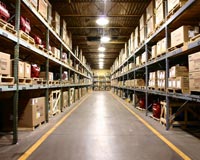Are there dinosaurs in South Yorkshire? No, not the big-toothed, roaring kind – the big, shed-shaped kind? Travel through the industrial heartlands of Yorkshire and the giant gleaming grey boxes are littered on either side of the motorway.
Once the epitome of mid-90s shed chic, these super-structures were a symbol of the area’s success – it’s glittering distribution future. But now they are part of the 15m sq ft of surplus space across the Yorkshire market, with roughly 13 years of take-up at present levels.
Agents talk of several buildings in South Yorkshire that, built in the exuberance of the boom, now look decidedly prehistoric. Although few are willing to name names, some now think that in sheer square footage these are a drag on the market and it is time they headed towards extinction.
“Some were simply the wrong buildings at the wrong time in the wrong locations,” says David Aspland, head of north commercial agency at Carter Jonas in Leeds. “There are not many of them, but perhaps in certain situations it’s time to look at them and decide how the owners might take some value out of them in a different way. However, even if landlords did take a haircut on these, it doesn’t guarantee they will ever be occupied again.”
Prehistoric ages
It’s a scary market out there. But while figures such as 15m sq ft and 13 years’ supply look horrific, they don’t tell the whole story. There has been no good quality stock delivered to the market for six or seven years, says Aspland, creating what he calls a precarious situation. Looking purely at good quality, Jones Lang LaSalle says there is 5.4 years of supply in Yorkshire, against a UK average of 4.3 years.
And that supply is patchy, as anything in more traditional markets has been snapped up, and in West Yorkshire the supply problem is chronic.
Richard Harris, partner and head of JLL’s industrial team in Leeds, says the lack of new product in all size ranges is starting to hold the market back.
“New development created demand and, because we are not seeing the product, the enquiry levels are not where we’d like them to be.
“It’s understandable. If your choice is a mid-90s unit that you are operating in, or relocation to another mid-90s unit, why would you relocate, unless you are under pressure for size?”
Savills estimates that there is close to 4m sq ft of new or good quality secondhand space in 18 buildings across the region (see below). None of the new units are in prime locations of West Yorkshire – all five are in South Yorkshire. Dave Robinson, director of national industrial and logistics at Savills, says: “There is a definite split between West and South Yorkshire. There is a lack of prime space in prime locations and the rest are in questionable locations.”
And that’s feeding into rent smaller end of the market, Robinson reckons a prime building in West Yorkshire would fetch £5 per sq ft, and it’s a 50 pence discount for South Yorkshire. Incentives are between six to nine months on a five-year lease, and in a secondary building you would still get a lengthy incentive. For a prime unit in Leeds, JLL is quoting £5.75 per sq ft. Nobody is willing to talk rental increases.
Yet neither Harris nor Robinson think it’s time to knock down the larger unoccupied buildings. “I think they will go – it is a matter of time. In Doncaster you get rates relief,” he says, addingthat this relieves a major pressurefor developers.
JLL’s Harris agrees. “A customer base is emerging that is looking for space that is impressive – it shows they are going places. These buildings are five to six years old, they have not been occupied and they are still subject to weathering, but the space is good. We just need that occupier to come along, and at this level the retail market is so key.”
In other words, there might not be a meteor heading for those dinosaur sheds just yet – they might have to stick around and fight it out. But some of them might just evolve in the end.
nadia.elghamry@estatesgazette.com











